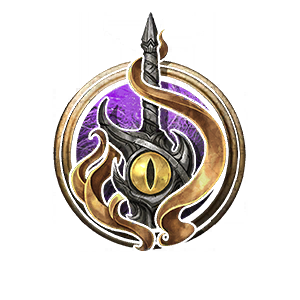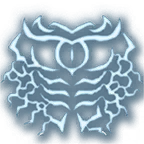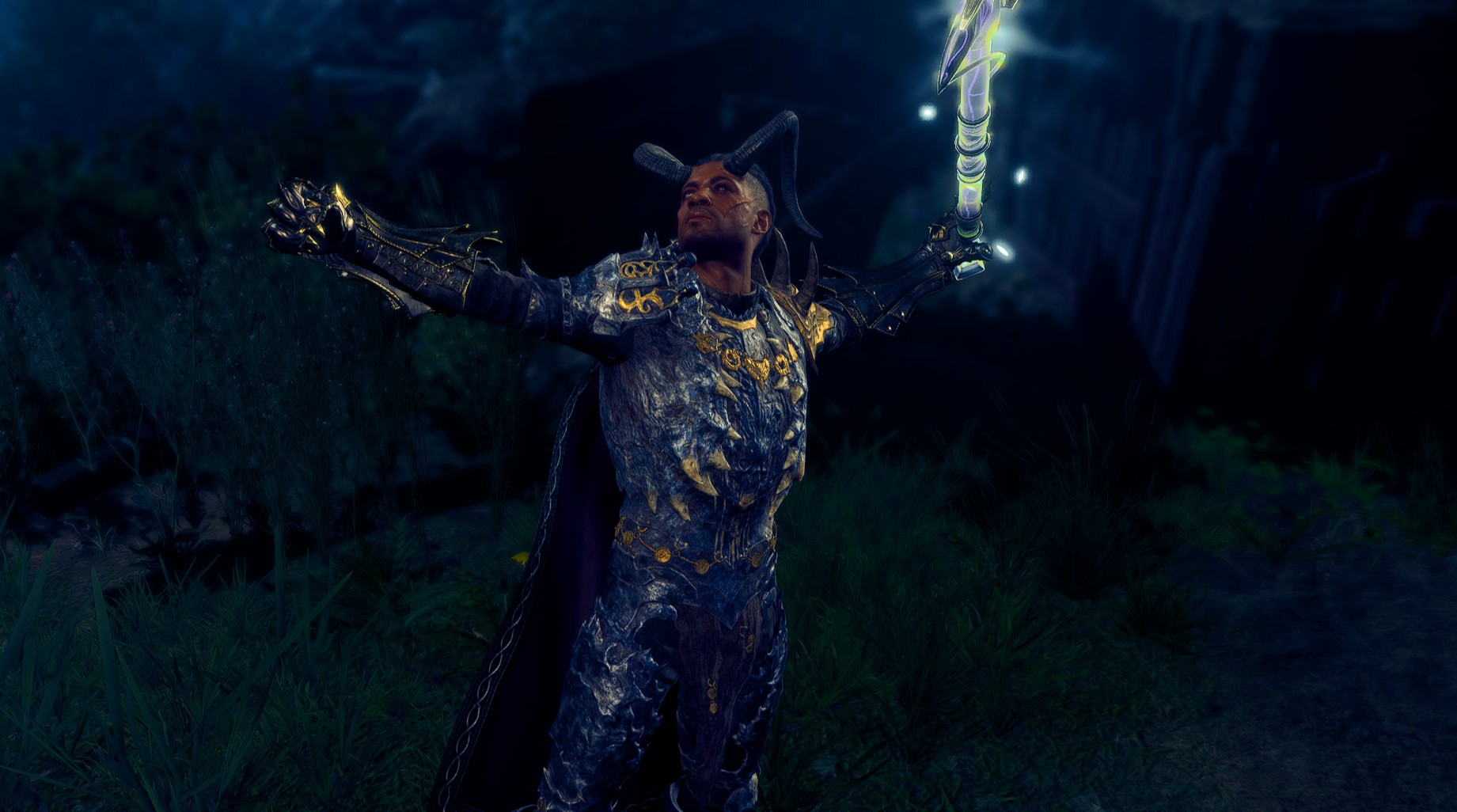 Wyll deserves better. Or, at the very least, he deserves to use his
Wyll deserves better. Or, at the very least, he deserves to use his  Warlock powers in order to use his melee weapons as well as he does in his introductory cutscene. And what better way to accomplish this than to realign his patronage with Mizora into his blade, which you can do by changing his Warlock subclass into
Warlock powers in order to use his melee weapons as well as he does in his introductory cutscene. And what better way to accomplish this than to realign his patronage with Mizora into his blade, which you can do by changing his Warlock subclass into  the Hexblade, newly introduced in Patch 8!
the Hexblade, newly introduced in Patch 8!
This build will let Wyll lean into frontline combat far more, turning him from a ranged caster into a magic-powered bruiser. Hexblade Wyll is capable of dealing massive damage and inflicting devastating status effects, while still having enough magical utility to control a battlefield. Out of combat, Wyll can use his Warlock  Charisma in order to easily be a party face, giving him plenty of utility, whether you are playing him as an Origin Character or he is just one of your companions.
Charisma in order to easily be a party face, giving him plenty of utility, whether you are playing him as an Origin Character or he is just one of your companions.
Build Summary
Because  The Hexblade is a unique, melee-centric caster subclass, and because
The Hexblade is a unique, melee-centric caster subclass, and because  Warlocks in general are a bit more hardy than most casters, this build exists in order to turn
Warlocks in general are a bit more hardy than most casters, this build exists in order to turn  Wyll into someone that can deal massive damage in melee (and endure hits in return). With more utility than most frontline fighters thanks to his magic, this build will allow you to disable and then destroy enemies, keeping them off the backs of your squishier party members.
Wyll into someone that can deal massive damage in melee (and endure hits in return). With more utility than most frontline fighters thanks to his magic, this build will allow you to disable and then destroy enemies, keeping them off the backs of your squishier party members.
And, because Warlocks use  Charisma to cast (and
Charisma to cast (and  Hexblades use
Hexblades use  Charisma as their weapon modifier), Wyll is also excellent at the head of the party. In dialogues, he can often talk potential enemies down (which also fits his characterization). The more forward action and likelihood to speak fits Wyll as a character better than his default Eldritch-Blast-based Fiend characterization, while keeping him as a Warlock so that his interactions with Mizora still make sense. If you are looking for a good, RP-friendly build for Wyll, look no further.
Charisma as their weapon modifier), Wyll is also excellent at the head of the party. In dialogues, he can often talk potential enemies down (which also fits his characterization). The more forward action and likelihood to speak fits Wyll as a character better than his default Eldritch-Blast-based Fiend characterization, while keeping him as a Warlock so that his interactions with Mizora still make sense. If you are looking for a good, RP-friendly build for Wyll, look no further.
Character Build Links
See this build at various levels (roughly corresponding with how the build should look by the end of each Act) in our Baldur’s Gate 3 Build Planner below:
Character Creation
Here are the starting stats, skills, and spells that you should select at the first level for  Hexblade
Hexblade  Warlock
Warlock  Wyll. Note that Wyll, as either an origin player character or a companion, will start with certain choices locked in (such as the Fiend subclass), and so you will need to go to Withers in order to respec Wyll into a Hexblade Warlock with the following stats.
Wyll. Note that Wyll, as either an origin player character or a companion, will start with certain choices locked in (such as the Fiend subclass), and so you will need to go to Withers in order to respec Wyll into a Hexblade Warlock with the following stats.
- Origin Character/Companion:
 Wyll
Wyll - Starting Class:
 Warlock
Warlock - Starting Subclass:
 The Hexblade
The Hexblade - Background:
 Folk Hero* (Automatic with
Folk Hero* (Automatic with  Wyll Origin)
Wyll Origin) - Abilities:
- Starting Cantrips:
- Starting Spells:
- Skill Proficiencies:
The reasons for the above choices should be self explanatory, but let’s walk through them:
For abilities,  Charisma should always be the highest for any
Charisma should always be the highest for any  Warlock, but especially a
Warlock, but especially a  Hexblade (who can use
Hexblade (who can use  Charisma not just to cast spells, but also as their weapon attack and damage modifier). The reason why we’ve set it to 17 instead of 16 is because we will be taking the
Charisma not just to cast spells, but also as their weapon attack and damage modifier). The reason why we’ve set it to 17 instead of 16 is because we will be taking the  Actor feat at Level 4, which will give Wyll 1 point in
Actor feat at Level 4, which will give Wyll 1 point in  Charisma (bringing it to 18), as well as numerous other benefits. The other stats were chosen in order of importance, prioritizing
Charisma (bringing it to 18), as well as numerous other benefits. The other stats were chosen in order of importance, prioritizing  Dexterity and
Dexterity and  Constitution as methods of increasing AC and HP, respectively, since Hexblade Wyll will need the extra durability now that he is on the front line.
Constitution as methods of increasing AC and HP, respectively, since Hexblade Wyll will need the extra durability now that he is on the front line.
The Cantrips are selected because both give Wyll some useful bonuses to have in melee combat. Booming Blade is one of the best Warlock spells for a Hexblade, enhancing the damage against any target that moves on its following turn, and  True Strike can make hitting enemies that much easier.
True Strike can make hitting enemies that much easier.  Shield as an initial first-level spell is useful in order to give Wyll some defensive options against opponents he’s trying to hold down, and Wrathful Smite — like most of the Smite spells — is good enough to be a signature for any Hexblade Warlock.
Shield as an initial first-level spell is useful in order to give Wyll some defensive options against opponents he’s trying to hold down, and Wrathful Smite — like most of the Smite spells — is good enough to be a signature for any Hexblade Warlock.
Finally, the skill proficiencies are based on the idea that Wyll is going to be a party face, doing a lot of the talking for the group.  Performance is selected because it will be important to get the boost from the
Performance is selected because it will be important to get the boost from the  Actor fear later.
Actor fear later.  Persuasion and
Persuasion and  Deception are avoided for now because Wyll is going to obtain them from the
Deception are avoided for now because Wyll is going to obtain them from the  Beguiling Influence Eldritch Invocation that he unlocks at Level 2. As for choosing between
Beguiling Influence Eldritch Invocation that he unlocks at Level 2. As for choosing between  Arcana,
Arcana,  History,
History,  Investigation, or
Investigation, or  Nature: this decision should be up to you as the player, but we will say that
Nature: this decision should be up to you as the player, but we will say that  Investigation is the skill that has the most associated checks (by a small margin).
Investigation is the skill that has the most associated checks (by a small margin).
Level Map for Feats & Abilities
Level 1
Level 2
At Level 2, we suggest selecting the following “Eldritch Invocations”, which you get two of.  Beguiling Influence gives Wyll proficiency in
Beguiling Influence gives Wyll proficiency in  Persuasion and
Persuasion and  Deception, letting him become a true party face that can easily engage in most dialogue. Armour of Shadows gives a spell (that takes no spell slot) that can increase Wyll’s AC by 3 — incredibly useful to keep him alive during tough battles.
Deception, letting him become a true party face that can easily engage in most dialogue. Armour of Shadows gives a spell (that takes no spell slot) that can increase Wyll’s AC by 3 — incredibly useful to keep him alive during tough battles.
 Hellish Rebuke and
Hellish Rebuke and  Armour of Agathys are both powerful defensive options that can punish enemies that hit Wyll. As you increase in level, it might be good to replace these spells with more powerful ones, but for now they are excellent choices.
Armour of Agathys are both powerful defensive options that can punish enemies that hit Wyll. As you increase in level, it might be good to replace these spells with more powerful ones, but for now they are excellent choices.
Level 3
None of the Pacts are particularly fantastic for a Hexblade, but the most thematically fitting is the  Pact of the Blade, which does grant some additional utility to your existing Hexblade powers. That said,
Pact of the Blade, which does grant some additional utility to your existing Hexblade powers. That said,  Pact of the Chain can be used to decent effect, simply because having any additional allies can provide good utility.
Pact of the Chain can be used to decent effect, simply because having any additional allies can provide good utility.
 Hold Person is just a roundly useful spell that can be used in many circumstances to get the upper hand and to deal easy crits, making it a no-brainer.
Hold Person is just a roundly useful spell that can be used in many circumstances to get the upper hand and to deal easy crits, making it a no-brainer.
Level 4
At level 4, you get to select from the list of general feats. Our recommendation is somewhat unorthodox: Actor. This not only increases your  Charisma — which is a Hexblade Warlock’s primary stat — but it also further raises Deception and Performance, the former of which is one of the most common skill checks in Baldur’s Gate 3.
Charisma — which is a Hexblade Warlock’s primary stat — but it also further raises Deception and Performance, the former of which is one of the most common skill checks in Baldur’s Gate 3.
 Blade Ward and
Blade Ward and  Branding Smite are obvious choices, both giving more optioins to melee-focused spellcasters.
Branding Smite are obvious choices, both giving more optioins to melee-focused spellcasters.
Level 5
At this Level, Wyll gets another Eldritch Invocation, and we begin to see one of the only drawbacks of the Hexblade Warlock: because so many of the Invocations are tailored to the typical “ranged spellcaster” style of most Warlocks, a lot of them are not incredibly useful to a Hexblade. The most useful, however, is  Sign of Ill Omen, which can make targets easier to hit, more likely to miss, and help you deal additional damage to them.
Sign of Ill Omen, which can make targets easier to hit, more likely to miss, and help you deal additional damage to them.
 Counterspell is one of the most broadly useful abilities in the game, letting you nullify dangerous magical foes.
Counterspell is one of the most broadly useful abilities in the game, letting you nullify dangerous magical foes.  Elemental Weapon is an obvious choice for any melee-based spellcaster, letting you capitalize on enemy weaknesses.
Elemental Weapon is an obvious choice for any melee-based spellcaster, letting you capitalize on enemy weaknesses.
Level 6
While the Accursed Spectre class feature is gained no matter what, it is very useful to keep in mind. By strategically cursing and then slaying weaker enemies in any given combat, Wyll can end up summoning several allies that can then be used to snowball his power level against stronger foes.
 Vampiric Touch is an absurdly strong spell that can help Wyll stay in the fight longer by siphoning HP.
Vampiric Touch is an absurdly strong spell that can help Wyll stay in the fight longer by siphoning HP.
- Feat:
-
 Accursed Spectre
Accursed Spectre
- Spell:
Level 7
At Level 7, you will get the choice between two powerful Eldritch Invocations.  Dreadful Word can give Wyll access to Confusion, which can be useful if you find that Wyll is not your only melee frontline character; it will allow him to weaken larger amounts of creatures while another front-liner helps him deal with them. If he is the only melee frontline character,
Dreadful Word can give Wyll access to Confusion, which can be useful if you find that Wyll is not your only melee frontline character; it will allow him to weaken larger amounts of creatures while another front-liner helps him deal with them. If he is the only melee frontline character,  Sculptor of Flesh will be more useful, as it will allow you to semi-permanently disable the toughest enemies in most encounters by
Sculptor of Flesh will be more useful, as it will allow you to semi-permanently disable the toughest enemies in most encounters by  Polymorphing them.
Polymorphing them.
- Feat:
- Spell:
- 4:
 Staggering Strike
Staggering Strike
Level 8
At this stage, it doesn’t make sense to do anything other than to take the  Ability improvement feat in order to max out Wyll’s
Ability improvement feat in order to max out Wyll’s  Charisma to 20 (at least from Feats). This will make his primary Ability modifier as powerful as it will get. If you have increased Wyll’s
Charisma to 20 (at least from Feats). This will make his primary Ability modifier as powerful as it will get. If you have increased Wyll’s  Charisma through some other method (such as from the Hag’s hair), then you should put the additional point into either
Charisma through some other method (such as from the Hag’s hair), then you should put the additional point into either  Dexterity or
Dexterity or  Constitution.
Constitution.
Worth noting, this is also the level where we begin recommending a short list of spells, which you should choose from based on your preferences and build.
Level 9
What you should obtain this level depends on your playstyle and party composition. If you are playing Wyll as a party face, then  Mask of Many Faces will give you a chance to make use of your great
Mask of Many Faces will give you a chance to make use of your great  Deception skill. If you do not have Grant Flight and don’t plan on getting it, then it is wise to get
Deception skill. If you do not have Grant Flight and don’t plan on getting it, then it is wise to get  Otherworldly Leap to increase your mobility.
Otherworldly Leap to increase your mobility.
All three Level 5 spells are great, though you should pick based on your party composition and playstyle.  Banishing Smite is the best if you find yourself wishing Wyll had better ranged options,
Banishing Smite is the best if you find yourself wishing Wyll had better ranged options,  Cone of Cold is the best AoE spell that can devastate groups, and
Cone of Cold is the best AoE spell that can devastate groups, and  Hold Monster is the best for single targets that tend to overpower the party if left unchecked. If you find yourself wanting two, we recommend replacing Hellish Rebuke with one of them.
Hold Monster is the best for single targets that tend to overpower the party if left unchecked. If you find yourself wanting two, we recommend replacing Hellish Rebuke with one of them.
Level 10
At Level 10, Hexblade Warlocks get the Armour of Hexes, which gives you a good reason to curse powerful, hard-hitting/accurate enemies. Doing so gives you the chance to avoid damage from their attacks as a reaction, which becomes very useful by the late game.
For Cantrips, there are several good options, but we recommend  Poison Spray or
Poison Spray or  Eldritch Blast the most, with a slight edge to
Eldritch Blast the most, with a slight edge to  Poison Spray (mostly because
Poison Spray (mostly because  Eldritch Blast benefits more from a dedicated build). There is an argument to be made for
Eldritch Blast benefits more from a dedicated build). There is an argument to be made for  Friends as well, if Wyll is truly the party face and you want to make sure you are succeeding endgame dialogue challenges with him.
Friends as well, if Wyll is truly the party face and you want to make sure you are succeeding endgame dialogue challenges with him.
For Spells, you should choose Dimension Door if you want your party to have more mobility and tactical options, or Phantasmal Killer if you just want more raw damage.
- Feats:
 Armour of Hexes
Armour of Hexes
- Cantrips & Spells: Choose One Cantrip and One Spell
Level 11
At this stage, you get access to a single Level 6 spell, the most powerful spell that you will ever get as a Warlock. You should be dealing plenty of damage with your normal abilities by now, and have a decent amount of mobility. This leaves a choice between  Eyebite, which will give you lots of options against wily foes, or
Eyebite, which will give you lots of options against wily foes, or  Flesh to Stone, which will turn difficult foes to stone temporarily. Both are about equally valuable, so pick based on personal preference.
Flesh to Stone, which will turn difficult foes to stone temporarily. Both are about equally valuable, so pick based on personal preference.
Most of the time, you should take whichever of the spells,  Dimension Door or
Dimension Door or  Phantasmal Killer, that you didn’t take last level. Some players may prefer Grant Flight,
Phantasmal Killer, that you didn’t take last level. Some players may prefer Grant Flight,  Blur, or
Blur, or  Hunger of Hadar, however.
Hunger of Hadar, however.
Level 12
For your final Eldritch Invocation,  Lifedrinker is such an obvious boon that, even as the last level capstone, it feels almost too powerful. For feats, you should choose between
Lifedrinker is such an obvious boon that, even as the last level capstone, it feels almost too powerful. For feats, you should choose between  Savage Attacker if you want more raw damage, or
Savage Attacker if you want more raw damage, or  Martial Adept (with Evasive Footwork and Precision Attack) if you want more options in combat.
Martial Adept (with Evasive Footwork and Precision Attack) if you want more options in combat.
For spells, you should have a good idea of what you need by Level 12, and it will depend largely on what other niches your party covers. We have given a few suggestions, most of which are utility spells that can cover bases in case other characters don’t.
Equipment
The following equipment is organized first by the Act you can acquire it in, and secondarily by slot (with the actual items in that slot being given in no particular order). An ideal build will try to acquire as much of the gear as possible, and will swap between the various options as different situations merit.
In general, we recommend high damage, status-effect-dealing weapons that can be wielded with two hands; high-AC medium armour; skill-boosting helms, gloves, and boots; and rings and amulets that give powerful spells or effects.
- Act 1:
- Bound Weapon: Very Heavy Greataxe, Everburn Blade, Hamarhraft, Intransigent Warhammer, Sword of Justice
- Secondary Hand: The Real Sparky Sparkswall
- Helm: Diadem of Arcane Synergy, Haste Helm, Mask of the Shapeshifter, The Lifebringer, Dark Justiciar Mask
- Clothing: Bloodguzzler Garb, Infernal Robe, The Protecty Sparkswall
- Armour: Spidersilk Armour, Adamantine Scale Mail, Hedge Wanderer Armour, The Jolty Vest
- Gloves: Bracers of Defence, Daredevil Gloves, Gloves of Baneful Striking, Gloves of Dexterity, Gloves of Power
- Boots: Boots of Genial Striding, Disintegrating Night Walkers, The Watersparkers, The Speedy Lightfeet
- Amulet: Amulet of Misty Step, Pearl of Power Amulet, Periapt of Wound Closure, Amulet of Lost Voices
- Rings: Caustic Band, Crusher’s Ring, Ring of Absolute Force, Ring of Colour Spray, Strange Conduit Ring
- Act 2:
- Bound Weapon: Moonlight Glaive, Halberd of Vigilance, Blood-Bound Blade, Charge-Bound Warhammer
- Secondary Hand: Absolute’s Protector, Sentinel Shield, Shield of Devotion
- Helm: Circlet of Mental Anguish, Coldbrim Hat, Flawed Helldusk Helmet
- Cloak: Cloak of Elemental Absorption, Vivacious Cloak
- Armour: Bided Time, Potent Robe, Sharpened Snare Cuirass, Yuan-Ti Scale Mail
- Gloves: Flawed Helldusk Gloves, Gloves of Battlemage’s Power, Swordmaster Gloves
- Boots: Boots of Apparent Death
- Amulet: Hammergrim Mist Amulet, Spellcrux Amulet, Surgeon’s Subjugation Amulet
- Rings: Coruscation Ring, Killer’s Sweetheart, Ring of Geniality, Risky Ring
- Act 3:
- Bound Weapon: Vicious Battleaxe, Hellfire Greataxe, Sethan, Balduran’s Giantslayer, Blackguard’s Sword, Woe, Hammer of the Just
- Secondary Hand: Abdel’s Trusted Shield, Shield of the Undevout, Viconia’s Walking Fortress
- Helm: Birthright, Gibus of the Worshipful Servant, Jannath’s Hat, Mask of Soul Perception, Helm of Balduran
- Cloak: Cloak of the Weave, Shade-Slayer Cloak
- Armour: Robe of the Weave, Armour of Agility, Flame Enamelled Armour, Unwanted Masterwork Scalemail
- Gloves: Bonespike Gloves, Gemini Gloves, Helldusk Gloves, Legacy of the Masters
- Boots: Helldusk Boots, Tyrannical Jackboots
- Amulet: Unflinching Protector Amulet, Amulet of Greater Health, Fey Semblance Amulet
- Rings: Orphic Ring, Band of the Mystic Scoundrel, Ring Of Regeneration



































































